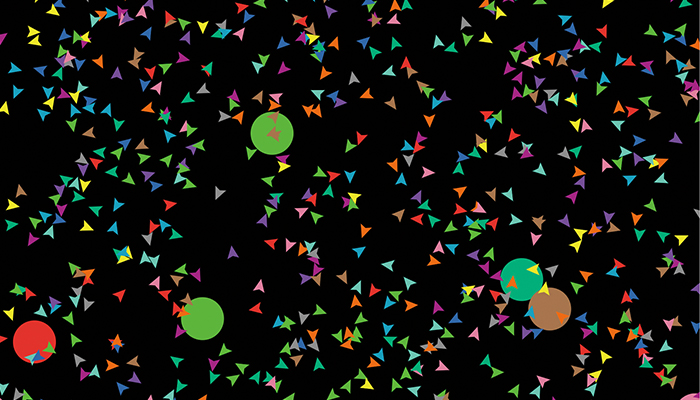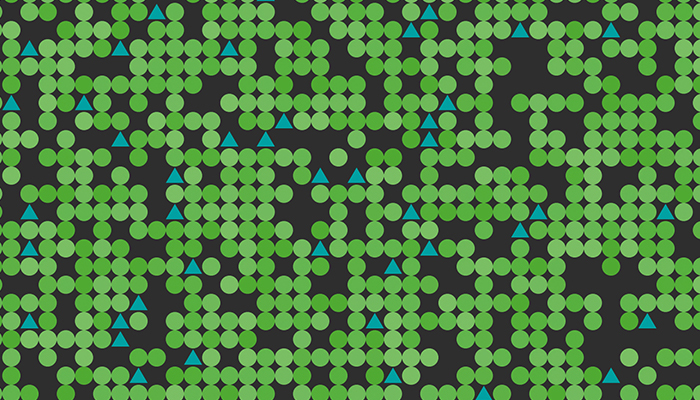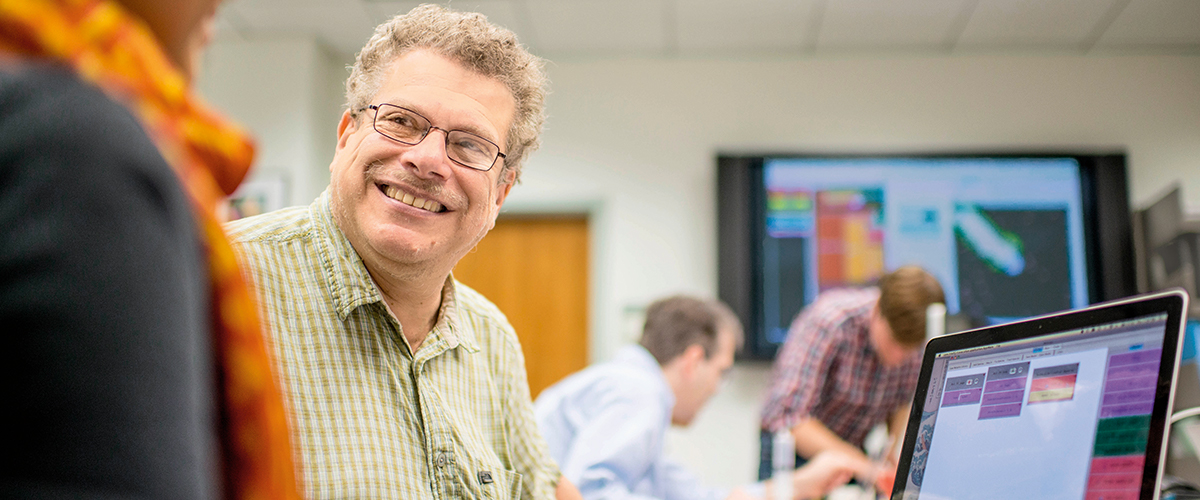Ahead of His Time
Uri Wilensky’s Radical Vision Takes Root
By Lisa Stein
Uri Wilensky realized more than 40 years ago that knowing how to frame problems with a computer is no less a core skill for school-aged kids than reading, 'riting, or 'rithmetic.
He envisioned teaching this approach to all students, not just those enrolled in computer science classes—a select few in American K–12 schools of the 1980s. Then, as he waited for the world to catch up to this unusual idea, he began to make it happen.
Today Wilensky, the Lorraine H. Morton Professor of Learning Sciences and Computer Science at the School of Education and Social Policy and the McCormick School of Engineering and Applied Science, is the father of a worldwide movement to harness the power of computer modeling and simulations and foster the mindset known as “computational thinking.” The intellectually voracious son of two university professors has drawn on his life experiences, international upbringing, and thirst for usable knowledge to motivate, teach, and empower students from pre-K to graduate school—and beyond.
His programmable NetLogo modeling environment has helped hundreds of thousands of students, teachers, and researchers tackle complex ideas ranging from the formation of crystals and galaxies to the patterns of wealth distribution, inequality, and segregation in a city.

ACTIVE BEATS PASSIVE
Rather than memorize equations and apply formulas to solve problems, people using Wilensky’s computer programs create, explore, and test simulations. An active experience, as opposed to a passive one, imparts context and meaning to learning, says Wilensky. “In order to solve societal problems—such as epidemics or traffic jams—we need to understand the world as thickly connected, as composed of networks, random events, and emergent phenomena,” he says. The more abstract the idea, the more likely we are to deem it genius, he continues, but often “abstract ideas are hard to grasp because the knowledge is represented in an incomplete way.”
Computational representations—or the depiction of knowledge as computer code— help illustrate how complexity emerges when elements in a system interact, which in turn “reveals more of what’s actually going on,” Wilensky explains. To keep our ecology in balance, for example, we need to see how global transportation networks can allow a random plant or animal to arrive in a foreign ecosystem, invade it, and dominate it.
Wilensky also believes that education is most effective when lessons are based on students’ interests and intuition. Or in other words, “We should have logic on tap, not on top”—to quote the late Seymour Papert, the renowned learning theorist, mathematician, and educational technology visionary who was Wilensky’s doctoral adviser at the Massachusetts Institute of Technology.
Wilensky and Papert’s groundbreaking work involved studying the historical development of representations and technologies to see how introducing more powerful systems impacts learning and knowledge.
Prior to the 14th century, for example, the use of Roman numerals made it hard for most people to do basic math. As society gradually moved to the current Hindu- Arabic system, even young children could learn how to multiply, divide, and more.
Wilensky and Papert hypothesized that novel ways of representing ideas can fundamentally alter how people learn—what they can grasp and do—and who is capable of doing it. The duo coined a term, calling such transformations “restructurations” of knowledge. With the advent of powerful computation, they said, representing ideas as computer code could improve computational literacy in the same way that moving to the Hindu-Arabic system increased the power and accessibility of arithmetic.

URI WILENSKY BY THE NUMBERS
- More than $40 million in grant money raised
- Over 350 scholarly publications
- Over 400 validated computational models
- His book An Introduction to Agent-Based Modeling, coauthored with William Rand and first published in 2015, has been reprinted five times.
NETLOGO
NetLogo, designed by Wilensky in 1999, was the vehicle he and Papert needed to test their theory. NetLogo helps users understand and visualize complex and interconnected phenomena, from the spread of diseases like HIV/AIDS and COVID-19 to the ways species interact and compete in stable ecosystems.
The software enables users to control the actions of agents—infected people, predatory animals, and so forth—in a simulated setting. A student using NetLogo would tell the agents how to behave, then watch what happens as they interact.
“NetLogo is not just software and not just a programming language. It’s an environment that changes the way you think,” says Wilensky’s colleague Mike Horn, associate professor of learning sciences and computer science.
Wilensky, who came to Northwestern in 2000, has long argued and demonstrated that when younger students learn conceptual science, technology, engineering, and math (STEM) content through a computational modeling approach, they can grasp the material as well as college students do.
His research also suggests that it’s easier to train teachers in computational thinking in their subject areas, such as chemistry or history, than to train and retain full-time computer science teachers, who are in short supply. This strategy of including many subject areas ensures that more students, including traditionally underrepresented groups, will have opportunities to learn computational thinking.
In the 1980s, however, the precursors of what would become NetLogo could only run on multimillion-dollar experimental research computers. People also doubted that children could learn difficult concepts with the help of computers in general. But after more than two decades of continuous development, Wilensky’s free, open-source tool is now the world’s most widely used agent-based modeling software.
“REALLY, REALLY GOOD TEACHERS”
Wilensky’s path to academia was perhaps preordained, yet he at first resisted the calling.
His father, Mordecai, convinced of an impending Nazi invasion, left Poland in 1934 as a teenager and settled in the Palestine/Israel region (then under the British mandate); his family later perished in Nazi death camps in Poland. Mordecai eventually received the first PhD awarded by the Hebrew University of Jerusalem and went on to teach history at Harvard, Oxford, and Haifa Universities and Hebrew College of Boston, among others.
Wilensky’s mother, Sarah, the daughter of a rabbi, grew up in Tzfat, a small city in northern Israel where girls generally didn’t attend school past eighth grade. She successfully lobbied her parents to let her enroll in a high school in Jerusalem, and she later attended Hebrew University. After meeting and marrying Mordecai, moving to Boston, and receiving a hard-won doctorate from Harvard, she eventually became a trailblazing philosophy professor and a long-serving department chair at Haifa University.
Wilensky spent most of his early childhood shuttling between Boston and Israel, where his parents settled when he was 14. They sent him to study at a yeshiva, hoping he might continue the family’s rabbinic line. Although his days were devoted to prayer and Talmudic study, Wilensky loved literature, psychology, philosophy, mathematics, science, and science fiction. “I questioned a lot of my teachers’ ideas—not to refute but to poke,” he says. “That didn’t go over very well.”
After graduating from Brandeis University with degrees in math, philosophy, and theater, Wilensky questioned whether academia was his destiny. He began designing commercial computer-aided design systems, collaborating with high-flying architects such as I. M. Pei, which convinced him that humans and computers can develop partnerships—and that these alliances were the way forward for science, society, and learning.
But Wilensky never forgot his parents’ dedication to their students. “Both of my parents were really, really good teachers, and I caught that bug,” he recalls. He returned to school, earning his PhD at MIT, and never looked back.
LAUNCHING LABS AND CAREERS
In the 21 years since NetLogo’s debut in K–12 classrooms, Wilensky has inspired scores of graduate students to pursue careers in learning sciences and computational modeling. He is the founding director of the Center for Connected Learning and Computer-Based Modeling, a research group that develops tools, learning environments, and curricula. He also founded and codirects Northwestern’s joint computer science and learning sciences doctoral program—the first of its kind in the US—and was a cofounder of the Northwestern Institute on Complex Systems.
Working with Wilensky had such a strong impact on postdoctoral fellow Sharona Levy, she switched fields to study learning complexity.
“My first impression of Uri was of a whirlwind of creative engagement with the understanding of ideas,” says Levy, now senior lecturer at the University of Haifa and director of its Systems Learning and Development Lab. “I was totally amazed by Uri’s ability to take any topic and ask pertinent, careful questions to get at the underlying structures.”
Inside Wilensky’s lab were people who were “passionate about the quality and depth of learning theories, educational technologies, and artificial intelligence,” says Paulo Blikstein (PhD09), a professor at Columbia University’s Teachers College.
“We cared about student empowerment, about building knowledge by actively constructing things in the world,” Blikstein says. “Uri was adamant on those principles. We cared about public education and social justice. It wasn’t just research for its own sake. It was also part of a larger idea of making schools more equitable and less oppressive.”
Beyond the work, however, Wilensky “creates a social environment that grows people to unexpected heights and results in people becoming fast and true friends,” Levy adds. “Uri’s unbound love of life, his always searching for—and finding—wonderful ways to experience the world, are a constant inspiration for me.”
NetLogo BY THE NUMBERS
- Millions of users worldwide
- Over a million student users
- Thousands of scientific research users
- Over 2,000 scientific articles on studies using NetLogo across all disciplines
